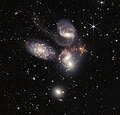Fichier:Stephan's Quintet taken by James Webb Space Telescope.jpg

Taille de cet aperçu : 625 × 599 pixels. Autres résolutions : 250 × 240 pixels | 501 × 480 pixels | 801 × 768 pixels | 1 068 × 1 024 pixels | 2 136 × 2 048 pixels | 12 654 × 12 132 pixels.
Fichier d’origine (12 654 × 12 132 pixels, taille du fichier : 63,39 Mio, type MIME : image/jpeg)
Historique du fichier
Cliquer sur une date et heure pour voir le fichier tel qu'il était à ce moment-là.
| Date et heure | Vignette | Dimensions | Utilisateur | Commentaire | |
|---|---|---|---|---|---|
| actuel | 12 juillet 2022 à 19:33 |  | 12 654 × 12 132 (63,39 Mio) | Habitator terrae | c:User:Rillke/bigChunkedUpload.js: |
| 12 juillet 2022 à 17:55 |  | 3 500 × 3 355 (4,94 Mio) | Yitzilitt | Uploaded a work by NASA from https://www.nasa.gov/image-feature/goddard/2022/nasa-s-webb-sheds-light-on-galaxy-evolution-black-holes with UploadWizard |
Utilisation du fichier
Les 3 pages suivantes utilisent ce fichier :
Usage global du fichier
Les autres wikis suivants utilisent ce fichier :
- Utilisation sur af.wikipedia.org
- Utilisation sur bn.wikipedia.org
- Utilisation sur de.wikipedia.org
- Utilisation sur en.wikipedia.org
- Utilisation sur en.wikiquote.org
- Utilisation sur fa.wikipedia.org
- Utilisation sur fi.wikipedia.org
- Utilisation sur he.wikipedia.org
- Utilisation sur hu.wikipedia.org
- Utilisation sur is.wikipedia.org
- Utilisation sur it.wikipedia.org
- Utilisation sur ja.wikipedia.org
- Utilisation sur ka.wikipedia.org
- Utilisation sur ko.wikipedia.org
- Utilisation sur kw.wikipedia.org
- Utilisation sur ml.wikipedia.org
- Utilisation sur ms.wikipedia.org
- Utilisation sur no.wikipedia.org
- Utilisation sur pl.wikipedia.org
- Utilisation sur pt.wikipedia.org
- Utilisation sur ro.wikipedia.org
- Utilisation sur te.wikipedia.org
- Utilisation sur tr.wikipedia.org
- Utilisation sur uk.wikipedia.org
- Utilisation sur zh.wikipedia.org




